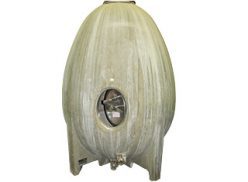
The concrete ovum led the innovation of concrete tanks.
Containers and wine cellars are practically synonymous, because neither can go without the other. Ceramic was already used as containers for the fermentation, storage and transport of wine during the Greek and Roman cultural periods. It does, however, appear that wine tanks are also exposed to fashion crazes. Since early in the twentieth century concrete tanks were generally used in international wine cellars, but it was gradually replaced by mild steel and glass fibre tanks. The mild steel tanks, however, had to be lined to prevent the influence of the metal on the wine and glass fibre tanks fell into disfavour for different reasons. Stainless steel consequently eventually dominated and is still a huge international industry. The development of stainless steel tanks occurred together with consumers’ demand for fresh, fruity wines, because stainless steel is practically inert.
Concrete is, however, presently attracting more interest as material for wine tanks. Initially it was only the egg-shaped ovum, which can be seen as a small container, but bigger concrete tanks are attracting more attention recently. The first ovum was developed by the French concrete tank manufacturer, Nomblot, upon a request from Michel Chapoutier, a French winemaker from the Rhône Valley. He was a dedicated supporter of biodynamic agriculture, as well as winemaking. He was convinced that an egg-shaped container has celestial energy, which causes the natural convection of the liquid in an ovum. The worldwide supporters of the ovum believe that the combination of the convection streams, which mix the yeast lees and wine naturally and the micro-oxygenation as result of the concrete’s porosity can contribute much to improve the fullness and complexity of wine’s taste.
Concrete can be used as material for a wide range of products. This includes amongst others wash basins, fireplaces and counter surfaces of tasting venues. The popularity of concrete tanks have increased again, because fermentation temperatures can be controlled easier, fruity flavours can be retained better, a fuller-bodied palate be caused, minerality promoted and micro-oxygenation can be created during storage due to the porosity of the concrete. Sonoma Cast Stone is a Californian Company which refined the manufacturing of concrete products. This includes amongst others computer-supported design (CAD) drawings, moulds that can be cut by computer-controlled laser technology, patented concrete blends and colour textures and finishing.
The use of concrete as material for wine containers is promoted by its strength and porosity. Concrete is presently a mixture of sand, water, crushed stone, cement and air. Sonoma Stone has different patented concrete blends, which are stain-free, glossy or environmental sustainable. Concrete used for wine tanks must be manufactured with chlorine-free water and no heavy metal traces should be present. The presence of chlorine can contribute to the potential mouldy character of wine and heavy metals like iron and copper can cause wine turbidity. Glass fibre is used for the physical fortification of smaller tanks, but secondary fortification like iron must be used for bigger tanks. Tank designs commence with CAD-drawings, which are converted into visual form by a 3D-printer. As result of the design moulds can be developed. Two moulds representing the inner and outer surface of the tank are put into each other, before the space between the moulds is filled with the required concrete blend. Prior to the filling, fixed equipment like manholes, racking valves and thermometers are positioned. Coolant pipes can also be fixed between the two moulds. The concrete between the moulds is left for two days to settle, before the moulds are removed. Tanks with capacities varying between 1 000 to 11 000 ℓ are available. Product development at the company is often driven by the inputs of clients. Nubarrel was developed as result of that. With a capacity of 1 200 ℓ it is especially suitable for smaller cellars or the experimental wines of bigger cellars. The specific capacity was chosen in order to fill or empty four x 300 ℓ barrels. It is ideal for space utilisation, because it has a cube form and can also be stacked. Although it will not replace barrels or tanks, the smaller capacity offers possibilities for experimenting with concrete as tank material (Pregler, 2016).
References
Pregler, Bill. 2016. What’s cool: Building a modern wine tank. Wine Business Monthly, December 2016: 44 – 49.
www.sonomastone.com.













